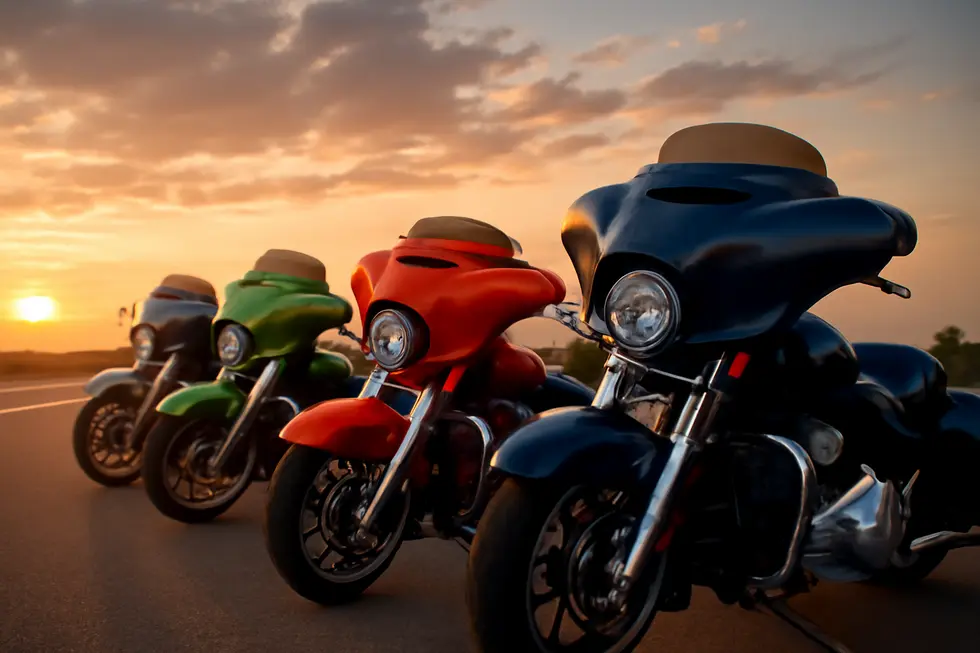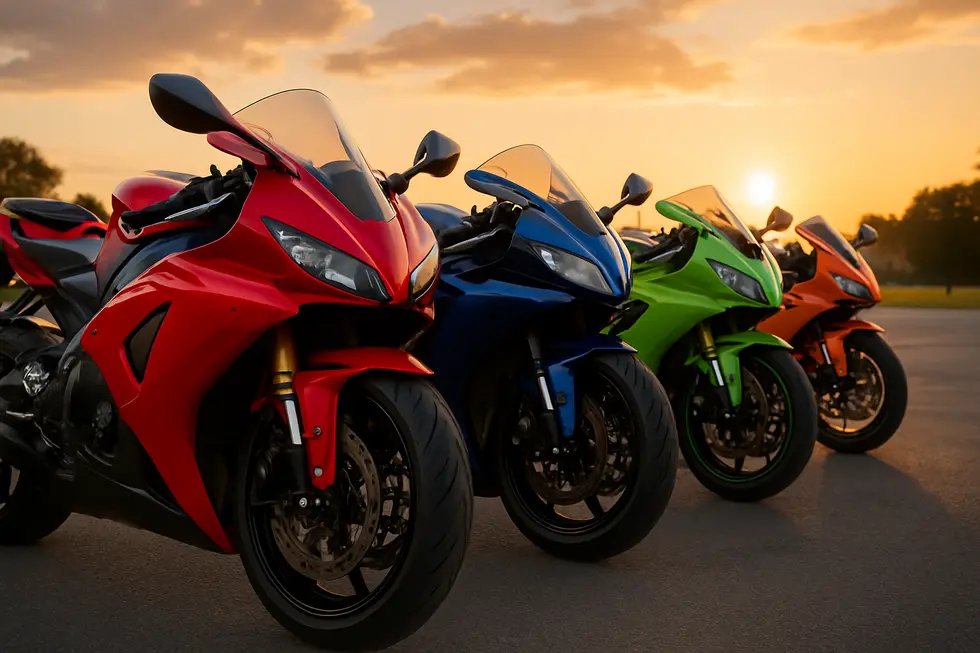Exploring Motorcycle Fairings: Your Essential Guide for Business Owners
October 19, 2025 | by summitfairings
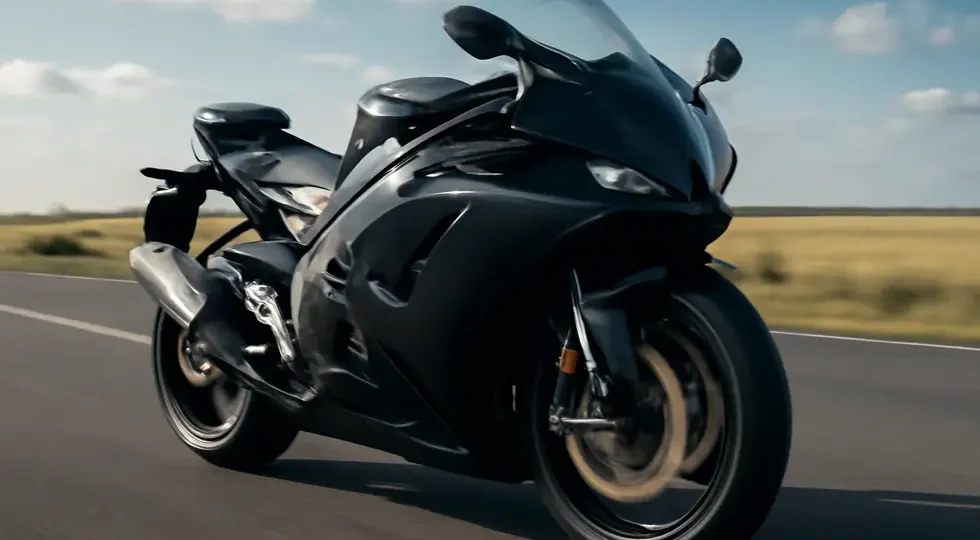
Introduction
Motorcycle fairings play a pivotal role in the design and functionality of modern motorcycles, particularly from a business perspective. For motorcycle manufacturers and retailers, understanding the intricacies of fairings can enhance product offerings, meet consumer demands, and drive sales. Whether you’re looking to improve your models aerodynamically or increase rider comfort, motorcycle fairings offer a plethora of benefits. This guide delves into the different types of motorcycle fairings, their historical significance, materials used in their construction, and the aerodynamic advantages they provide. By the end of this exploration, you will understand how these elements interplay to shape a successful product strategy in the motorcycle market.
Tables of Contents
Chapter 1: Diving Deeper into the Varieties of Motorcycle Fairings
- A Comprehensive Guide to the Different Types of Motorcycle Fairings
- Diverse Classes of Motorcycle Fairings: A Comprehensive Look
- Examining the Diversity of Motorcycle Fairings: Materials and Designs
- Diverse Types of Motorcycle Fairings: Custom and Aftermarket Innovations
- The Integral Role of Fairings in Enhancing Motorcycle Performance
Chapter 2: The Evolution and Impact of Motorcycle Fairings
- A Journey Through the Development of Motorcycle Fairings
- Critical Transformations in Motorcycle Fairing Design
- Historical Evolution and Personalization of Motorcycle Fairings
- Racing Dynamics and Sponsorship: Shaping the Future of Motorcycle Fairings
- The Transformative Role of Motorcycle Fairings in Enhancing Performance and Comfort
Chapter 3: Analyzing the Components: Materials and Cost in Motorcycle Fairings
- Evaluating the Durability and Financial Implications of Fairing Materials in Motorcycling
- Balancing Durability and Performance: A Dive into Fairing Materials
- Maximizing Performance: Weight Advantages of Motorcycle Fairing Materials
- The Interplay of Material Selection and Visual Appeal in Motorcycle Fairings
- Material Preferences: Understanding Market Trends in Motorcycle Fairings
Chapter 4: Enhancing Motorcycle Performance Through Aerodynamics and Comfort
- Unlocking Speed and Comfort: The Key Role of Motorcycle Fairings in Aerodynamic Efficiency
- Unveiling the Aerodynamic Advantages and Comfort Enhancements of Motorcycle Fairings
- Speed and Stability: The Aerodynamic and Comfort Innovations of Motorcycle Fairings
- Fueling Savings: The Economic Benefits of Motorcycle Fairings’ Aerodynamics
- Aerodynamic Design and Rider Comfort: The Dual Impact of Motorcycle Fairings
Chapter 1: Diving Deeper into the Varieties of Motorcycle Fairings
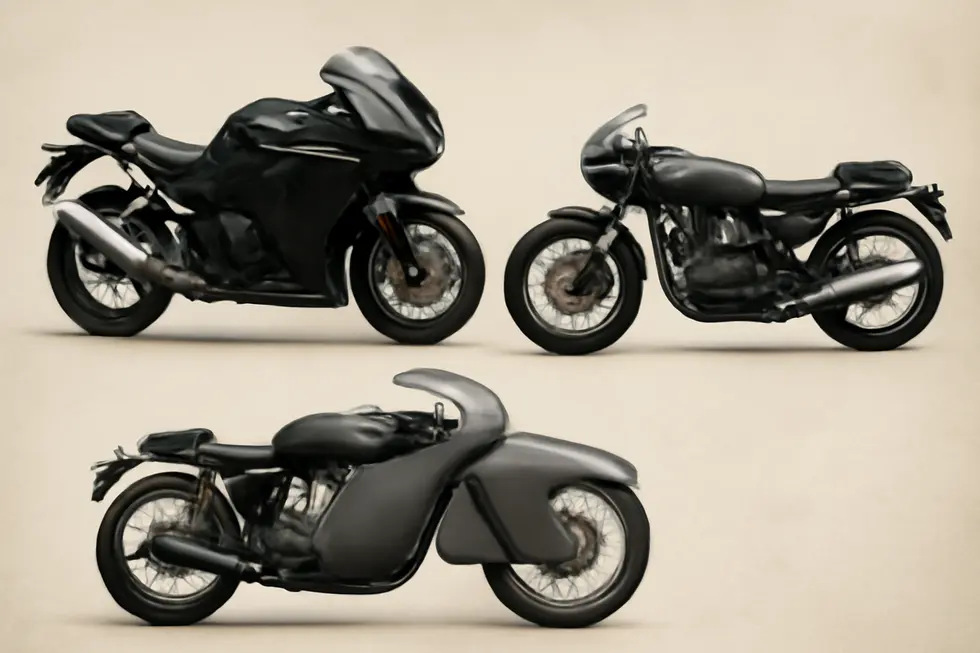
1. A Comprehensive Guide to the Different Types of Motorcycle Fairings
Motorcycle fairings are essential components that enhance a bike’s functionality and aesthetics. They are classified primarily into several types, each designed for specific riding experiences and objectives. Full fairings cover the motorcycle’s front and sides completely, optimizing aerodynamic efficiency and rider wind protection, exemplified by the legendary BMW R100RS from 1977. Half fairings, in contrast, provide limited coverage around the headlight and handlebars, balancing some wind shielding with spare weight. For minimalistic needs, quarter fairings shield merely the headlight area. Racing enthusiasts often opt for race fairings, which are lightweight and maximize speed, while touring fairings prioritize rider comfort on long journeys, incorporating features like windshields and storage spaces. Other variants, like clip-on fairings, are common among sportbikes, further highlighting the diversity and specialization in motorcycle fairings. For tailored solutions and extensive selections, visit resources like Summit Fairings.
2. Diverse Classes of Motorcycle Fairings: A Comprehensive Look
Motorcycle fairings are crucial components that enhance performance and rider comfort, distinguished by their unique designs tailored for specific riding styles. Full fairings envelop the entire front and sides, significantly improving aerodynamics and shielding riders from harsh winds; the BMW R100RS pioneered this design in 1977. In contrast, half fairings cover only the upper front, such as the Yamaha XJ6 Diversion from 2009, providing a balance between wind protection and mechanical visibility. For a minimalist approach, quarter fairings offer a sleek profile, shielding just the headlight, while bagger fairings, like those on the Indian Challenger, blend style with functionality by integrating storage solutions. Additionally, retro fairings appeal to enthusiasts seeking classic aesthetics, making them popular in vintage models. Customization options abound, granting riders the ability to personalize their fairings with varied materials and colors, enhancing both appearance and performance. For more insights into these fascinating designs, visit Summit Fairings.
3. Examining the Diversity of Motorcycle Fairings: Materials and Designs
Motorcycle fairings play a crucial role in enhancing performance through various designs, notably full, half, and quarter fairings. Full fairings encompass the whole motorcycle, significantly reducing drag and providing maximum wind protection, although they are typically heavier and can be pricier. In contrast, half fairings cover the front and sides, striking a balance between protection and reduced weight, albeit at the expense of wind shielding. Lastly, quarter fairings offer the most minimal design, prioritizing headlight and windscreen shielding. The materials used in fairings—ABS plastic, fiberglass, and premium options like carbon fiber—affect weight, durability, and cost. Choosing the right fairing hinges on multiple factors, including aerodynamics, rider needs, and aesthetic preferences. For more insights on motorcycle fairings, visit Summit Fairings.
4. Diverse Types of Motorcycle Fairings: Custom and Aftermarket Innovations
Motorcycle fairings are crucial not only for their functionality but also for their aesthetic appeal. Full fairings offer optimal aerodynamic benefits and rider protection, making them a staple on sport and touring bikes. In contrast, half fairings provide moderate coverage, popular among standard models, while quarter fairings cater to cruisers with minimalistic designs. For those who prefer an unencumbered look, naked bikes eliminate fairings altogether, showcasing their mechanical beauty.
However, customization plays a significant role in the motorcycle culture. Custom fairings can be tailored to enhance both the aesthetics and performance of a bike, with materials ranging from fiberglass to carbon fiber. On the other hand, aftermarket fairings, crafted by third-party manufacturers, offer a plethora of choices—affordability and unique styles often driving riders to explore these options. For comprehensive insights on fairing types and materials, resources like Summit Fairings are invaluable.
5. The Integral Role of Fairings in Enhancing Motorcycle Performance
Motorcycle fairings are far more than mere aesthetic additions; they are integral components that dramatically influence the motorcycle’s performance and rider experience. Designed primarily to improve aerodynamics, they reduce wind resistance, which not only boosts top speed but also enhances fuel efficiency. For example, full fairings cover the entire front of the bike, enveloping the engine and frame for maximum wind deflection. This design helps mitigate wind buffeting—an issue that can sap rider energy and comfort on long rides. Moreover, fairings house crucial equipment, such as headlights and instruments, seamlessly blending functionality with style. Additionally, features like adjustable windscreens offer riders a way to customize airflow according to personal preferences and riding conditions. With the right fairing, motorcyclists can enjoy enhanced stability, comfort, and safety, which are essential for an optimal riding experience. For more insights into the variety and customization of motorcycle fairings, discover unmatched choices at Summit Fairings.
Chapter 2: The Evolution and Impact of Motorcycle Fairings
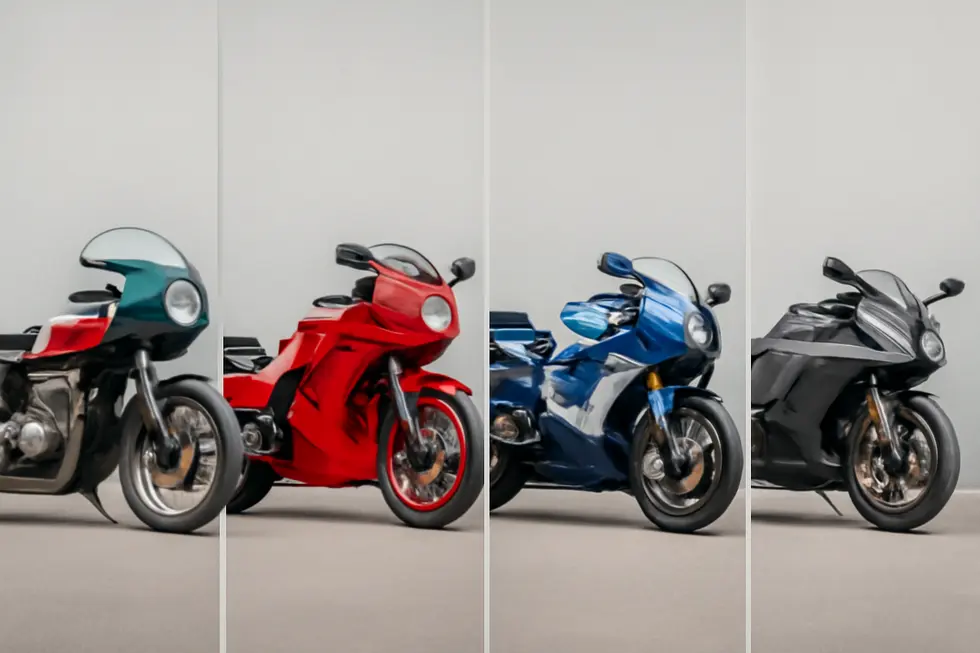
1. A Journey Through the Development of Motorcycle Fairings
Motorcycle fairings have undergone an impressive transformation, evolving from rudimentary windshields to sophisticated aerodynamic structures that enhance performance. Their journey began in the early days of motorcycling, where the need to reduce wind resistance emerged as a fundamental concern for riders. The game changed significantly with the introduction of the BMW R100RS in 1977, showcasing a full fairing and paving the way for more aerodynamic designs in subsequent decades. As motorcycling grew in popularity, particularly in racing, the design and functionality of fairings saw rapid improvements, incorporating advanced materials and technology to maximize aerodynamic efficiency. The late 20th century witnessed manufacturers like Harley-Davidson integrate fairings into their touring models, enhancing comfort and handling. Thus, motorcycle fairings became not only vehicles of aerodynamics but also symbols of style, safety, and rider comfort, shaping the modern motorcycle experience. For more insights into motorcycle fairings, explore the latest offerings at Summit Fairings.
2. Critical Transformations in Motorcycle Fairing Design
The evolution of motorcycle fairings is a fascinating journey marked by pivotal innovations that have redefined not only aesthetics but also performance and safety. Beginning in the early 20th century, fairings were largely unrefined, primarily utilized in the racing world or as aftermarket modifications. A notable breakthrough occurred in 1977 with the BMW R100RS, the first mass-produced motorcycle to feature a full factory fairing. This innovation set a new standard for aerodynamics and rider protection. The 1980s further ushered in advancements, exemplified by Harley-Davidson’s Tour Glide, which introduced frame-mounted fairings, enhancing stability in various conditions. In recent years, the focus has shifted toward high-performance racing, with manufacturers like Ducati integrating cutting-edge technologies such as ground-effect aerodynamics in MotoGP models. This ongoing transformation reflects the constant interplay between rider comfort, safety, and the quest for speed. For a deeper dive into the array of motorcycle fairings available today, explore the diverse choices at Summit Fairings.
3. Historical Evolution and Personalization of Motorcycle Fairings
Motorcycle fairings have come a long way since their inception, evolving from rudimentary wind deflectors to sophisticated aerodynamic structures that significantly enhance both performance and appearance. The BMW R100RS, released in 1977, marked a pivotal moment in this evolution, showcasing the potential of full fairings to improve speed and stability. As materials advanced in the 1980s, customization took center stage, with riders modifying their fairings to reflect personal style and enhance functionality. This trend coincided with the rise of performance motorcycles, as manufacturers began to offer more diverse and intricate designs. Today, fairings are not just about aerodynamics; they encapsulate artistic expression and brand identity, exemplified by iconic models featuring custom logos or designs. Events like custom bike shows highlight this flourishing culture, inspiring a new generation of motorcyclists to blend form with function in their journeys.
4. Racing Dynamics and Sponsorship: Shaping the Future of Motorcycle Fairings
The evolution of motorcycle fairings is wildly intertwined with the realms of racing and sponsorship, marking milestones that propelled this technology forward. The groundbreaking introduction of the BMW R100RS in 1977 established the factory-produced full fairing, a design engineered for enhanced aerodynamics and improved rider protection. As motorcycles sped into the future, racing demands drove innovations focused on minimizing air resistance and maximizing stability.
During the 1980s, advancements in fairing designs adapted to high-performance needs, reflecting integrated technology like monoshock suspensions. Simultaneously, the custom fairing movement emerged, showcasing how competitive designs influenced street bike aesthetics and functionality. Sponsorship further accelerated this evolution, merging branding with performance enhancements and promoting visibility that catalyzed technical innovation in the motorcycle industry. This dynamic interplay established fairings as essential to modern motorcycle design, serving both aerodynamic and marketing purposes.
5. The Transformative Role of Motorcycle Fairings in Enhancing Performance and Comfort
The evolution of motorcycle fairings drastically reshaped motorcycle design, particularly after the 1977 debut of BMW’s R100RS, the first factory-produced full fairing. This innovation marked a departure from sporadic aftermarket fairings, leading manufacturers to emphasize not only aesthetics but also performance and comfort. By minimizing aerodynamic drag—an essential factor in achieving higher speeds and better fuel efficiency—fairings became vital in the late 20th century. As speeds in racing and commercial motorcycles increased, fairings offered riders significant protection from wind and debris, thus enhancing long-distance comfort at high velocities. As innovation surged in the 1980s, with companies like Zzipper popularizing aerodynamic designs, fairings became standard features on sport and superbikes, ultimately setting a benchmark in motorcycle engineering that combined sleek design with rider safety. For those looking to explore a wide range of motorcycle fairings, check out Summit Fairings.
Chapter 3: Analyzing the Components: Materials and Cost in Motorcycle Fairings
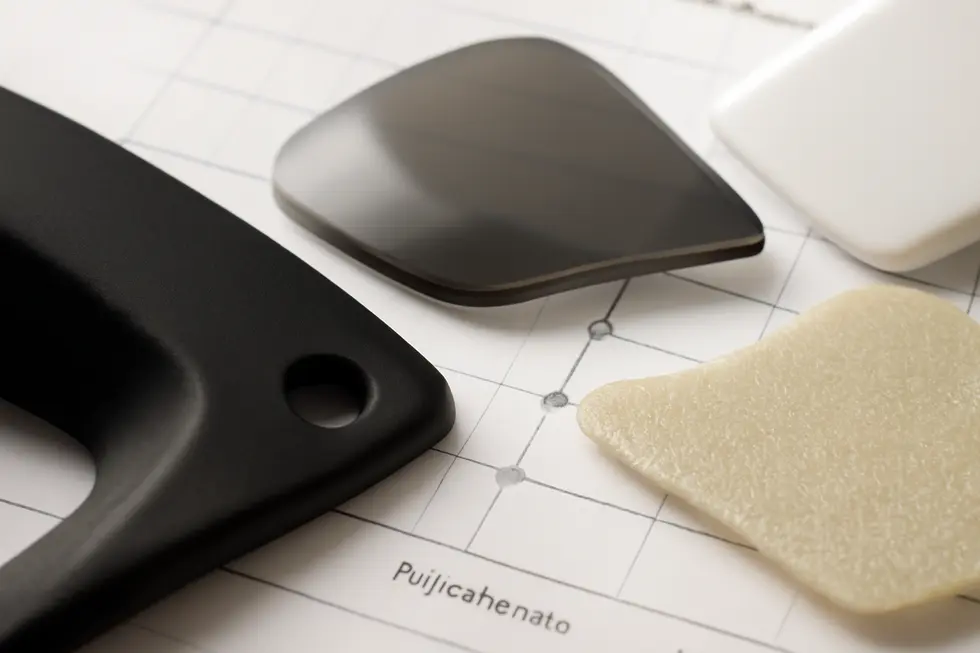
1. Evaluating the Durability and Financial Implications of Fairing Materials in Motorcycling
The materials utilized in motorcycle fairings—ABS plastic, fiberglass, and carbon fiber—each bring unique characteristics to the riding experience, particularly regarding durability and cost.
ABS plastic offers a commendable blend of flexibility and impact resistance, making it the preferred option for reliability among riders. With prices typically between $300 to $800, this material balances durability with an OEM-like fit, catering to the average rider’s budget.
Conversely, fiberglass, while more affordable at $150 to $300, tends to be brittle and requires significant finishing work, including sanding and painting, diminishing its suitability for those seeking long-lasting performance.
On the premium end is carbon fiber, which shines in strength and lightness, though its vulnerability to sharp impacts could be a concern. With costs often exceeding $1,000, it targets enthusiasts desiring performance and aesthetics.
Additionally, paint finishes and shipping costs further influence the overall pricing, potentially elevating the final expenditure. Riders frequently find that ABS plastic strikes the optimal balance between resilience and affordability.
2. Balancing Durability and Performance: A Dive into Fairing Materials
Motorcycle fairings are composed of materials such as ABS plastic, fiberglass, and carbon fiber, each selected for its unique balance of impact resistance and flexibility. ABS plastic, prevalent in factory and aftermarket offerings, is favored due to its sturdiness and adaptability, allowing it to absorb shocks without cracking and fit snugly against the motorcycle frame. In contrast, fiberglass, known for its affordability, tends to be more brittle, often cracking instead of bending under impact; however, it offers easy repair options. On the premium side, carbon fiber showcases an impressive strength-to-weight ratio, making it ideal for racing applications, but its higher cost limits accessibility. Understanding these material properties is crucial not just for performance, but for ensuring safety and longevity in motorcycle applications, as highlighted at Summit Fairings.
3. Maximizing Performance: Weight Advantages of Motorcycle Fairing Materials
The choice of materials for motorcycle fairings plays a critical role in optimizing performance, particularly concerning weight advantages. The most prevalent materials—ABS plastic, fiberglass, and carbon fiber—each present unique characteristics.
ABS plastic, while generally heavier, strikes a commendable balance between affordability and durability, with complete fairing kits weighing around 3.5 to 4.5 kg. This makes it favored for entry-level motorcycles. Conversely, fiberglass offers a moderate weight advantage, typically between 2.8 and 3.6 kg, while also being easier to repair, appealing for those seeking aftermarket solutions. Lastly, carbon fiber, the featherweight champion at just 2.0 to 2.5 kg, is ideal for performance applications where every gram counts. Despite its higher cost, its superior strength and lightweight properties significantly enhance acceleration and handling. Relying on budget and performance needs, riders can find their ideal fairing material for improved ride dynamics. For comprehensive insights into fairing options, check out Summit Fairings at their resource-packed blog.
4. The Interplay of Material Selection and Visual Appeal in Motorcycle Fairings
Motorcycle fairings are pivotal not only for performance but also for the aesthetic identity of a bike. The materials chosen for fairings significantly influence their appearance and perceived quality.
ABS Plastic is favored due to its affordability and impact resistance, allowing for intricate designs that enhance sporty looks. In contrast, fiberglass permits extensive customization but requires considerable finishing to achieve a polished appearance. Carbon fiber, known for its lightweight properties, delivers a sleek and exotic look but comes at a premium.
The artistic potential of these materials means they can be easily painted, allowing for creative expression through custom designs. Regardless of choice, maintenance through buffing and protective coatings is crucial for preserving the vibrant finish against wear. Balancing aesthetics with usability ensures riders enjoy motorcycles that are as visually striking as they are functional. Explore more at Summit Fairings for diverse options.
5. Material Preferences: Understanding Market Trends in Motorcycle Fairings
The materials used in motorcycle fairings greatly influence consumer preferences and market dynamics. ABS plastic leads the market with its excellent combination of durability, flexibility, and affordability. Riders appreciate its impact resistance and OEM-like fit at prices ranging from $300 to $800. Conversely, fiberglass is a cost-effective alternative suited to budget-conscious consumers, although it’s less durable and requires more finishing work, typically costing between $150 to $300. On the premium side, carbon fiber draws in enthusiasts desiring lightweight performance and aesthetics, priced significantly higher, often exceeding $600. Recent trends indicate a shift toward more advanced materials, especially with the rise of electric motorcycles, where lightweight options contribute to improved efficiency. This diversification reflects an overarching demand for innovative materials that cater to various performance metrics and aesthetic preferences.
Chapter 4: Enhancing Motorcycle Performance Through Aerodynamics and Comfort
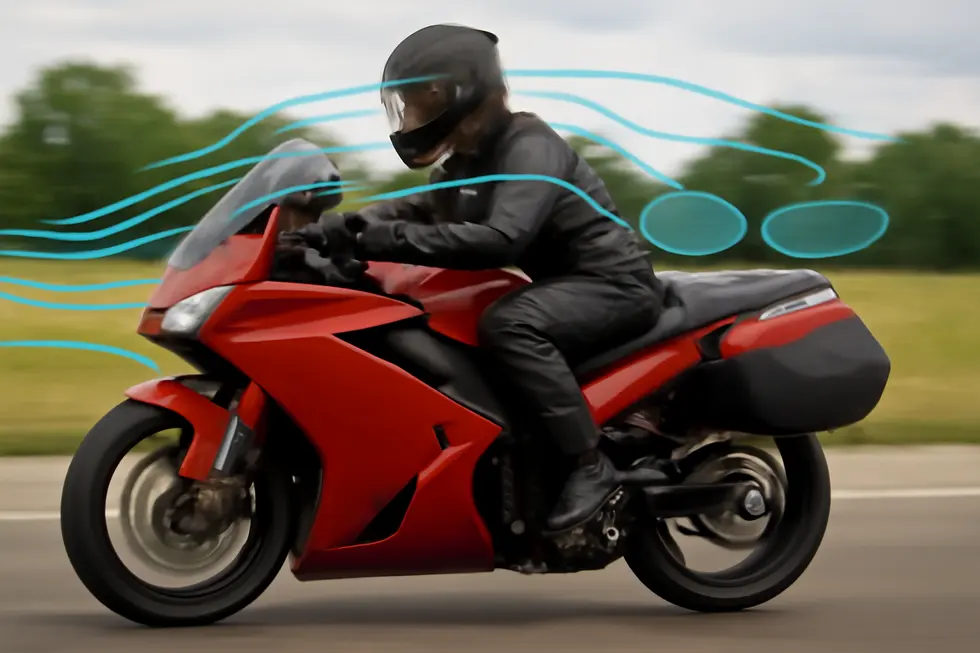
1. Unlocking Speed and Comfort: The Key Role of Motorcycle Fairings in Aerodynamic Efficiency
Motorcycle fairings serve a vital function in enhancing both aerodynamic efficiency and rider comfort. By optimizing airflow around the bike, they reduce drag significantly, allowing motorcycles to reach higher speeds with less energy and improving fuel efficiency, especially for electric models where every bit of reduced resistance counts. The smooth contours of modern fairings direct air seamlessly, contributing to stability even at high velocities and during sharp turns. Features like winglets further refine aerodynamics by generating downforce, which is crucial for superior handling. Additionally, fairings protect riders from adverse weather and road debris, creating a more enjoyable experience. The design also minimizes turbulence around the rider, decreasing the fatigue often caused by buffeting winds. Choosing the right materials for fairings, such as lightweight ABS plastic or advanced carbon fiber, balances cost and performance, ensuring the motorcycle performs exceptionally while delivering comfort on the road. For those seeking quality fairings, exploring options can be invaluable.
2. Unveiling the Aerodynamic Advantages and Comfort Enhancements of Motorcycle Fairings
Motorcycle fairings are pivotal in transforming the riding experience by significantly improving aerodynamics and rider comfort. By reducing wind resistance, fairings create a streamlined environment that enhances stability, boosts top speeds, and optimizes fuel efficiency. For instance, the 2025 Ducati Panigale V4 showcases a fairing design that minimizes aerodynamic drag by 4%, enveloping the rider in a ‘bubble’ of calm air, thereby improving handling and comfort against side winds. Furthermore, these shell structures act as a protective barrier, shielding the rider from harsh weather and road debris. This design not only lowers the wind pressure exerted on the rider’s body, enhancing comfort—especially on long rides—but also helps to reduce fatigue. Ultimately, fairings are essential for creating a stable and enjoyable riding environment, embodying a blend of performance and rider protection that makes modern motorcycles exhilarating and user-friendly.
3. Speed and Stability: The Aerodynamic and Comfort Innovations of Motorcycle Fairings
Motorcycle fairings are pivotal in optimizing both speed and rider comfort. Their sleek designs minimize drag, allowing for smoother airflow, which significantly enhances stability and fuel efficiency during rides. For instance, the 2025 Ducati Panigale V4 showcases a 4% reduction in aerodynamic resistance through its redesigned fairing, effectively creating a protective bubble of calm air around the rider, increasing downforce and stability at high speeds. Beyond performance, fairings also protect riders from harsh wind blasts and environmental elements, drastically reducing fatigue, especially on long rides. The integration of advanced materials like carbon fiber into fairing designs contributes to lightweight structures, promoting better handling without sacrificing durability. Moreover, innovations such as winglets, inspired by MotoGP technology, enhance traction and control. Ultimately, motorcycle fairings represent a confluence of technology and design that enriches the riding experience.
4. Fueling Savings: The Economic Benefits of Motorcycle Fairings’ Aerodynamics
Motorcycle fairings are ingeniously designed to enhance aerodynamics, resulting in significant economic benefits through improved fuel efficiency. Their streamlined profiles effectively reduce drag, particularly at higher speeds, allowing riders to travel further on less fuel. For instance, aggressive fairings, tailored for optimized airflow, can yield noteworthy fuel economy improvements, directly affecting a rider’s bottom line.
Moreover, fairings shield riders from wind and adverse weather, enhancing comfort and stability. Reduced wind buffeting translates to less fatigue during longer rides, promoting safer outings. Economically, lower fuel consumption equates to decreased operational costs. Frequent riders, like commuters or delivery workers, can realize substantial savings over time, often offsetting fairing costs that range from $80 to $600. Investing in high-quality fairings not only preserves the motorcycle’s value but also contributes to a more enjoyable riding experience, making it an essential consideration for serious motorcyclists. For expanded insights on motorcycle fairings and their economic advantages, check out affordable motorcycle fairings options available at Summit Fairings.
5. Aerodynamic Design and Rider Comfort: The Dual Impact of Motorcycle Fairings
Motorcycle fairings serve a pivotal role in enhancing both aerodynamic efficiency and rider comfort. By minimizing air resistance, fairings reduce aerodynamic drag, essential for maintaining higher speeds and optimizing fuel efficiency. For instance, advanced models like the Ducati Panigale V4 utilize redesigned fairings that improve airflow management, yielding a decrease in drag and enhancing downforce for better traction during cornering. Moreover, fairings create a protective barrier against wind and elements, resulting in significant comfort for riders. Features such as larger windscreens found on touring bikes not only shield against the elements but also reduce fatigue caused by wind pressure on the rider’s body. This integration of aerodynamics and comfort ultimately contributes to a safer riding experience, as stability at high speeds is paramount for any motorcyclist.
Final thoughts
The insights into motorcycle fairings reveal a comprehensive understanding of their contributions to performance, aesthetics, and rider experience. As a business owner, leveraging this knowledge can elevate your product offerings and meet customer expectations for quality and functionality. By choosing the right types of fairings, recognizing their historical significance, and utilizing modern materials effectively, you can differentiate your brand in a competitive market. This strategic approach will not only enhance the riding experience for consumers but also solidify your position as a leader in the motorcycle industry.
Ready to elevate your ride? Summit Fairings delivers premium, custom-fit fairings that blend style and durability. Whether you’re chasing speed or turning heads, we’ve got your bike covered. Don’t wait—transform your machine today. Click, customize, and ride with confidence. Your perfect fairing is just a few clicks away. Act now!
About us
undefined
RELATED POSTS
View all

